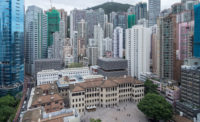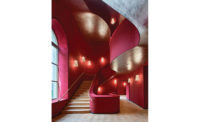You expect clinics to look, well, clinical—Modernist, austerely immaculate boxes, hygienically white inside and out. REHAB Basel, a privately run clinic for spinal-cord and brain injuries, ingeniously subverts the stereotype while bolstering its therapeutic goals. It appears residential and natural—though not with a funky, down-home earthiness, but a crisply turned-out mien. Here, oak, pine, larch, and ironwood enclose and screen exterior walls, and a rectilinear plan brings daylight and landscape into its precincts through courtyards, grassy roofs, glazed walls, upper-level decks, and skylights.
In providing 92 beds in double and single rooms, where patients with spinal-cord or brain injuries can stay up to 18 months, the clinic directors eschewed the institutional hospital look. Gone is the typical maze of corridors and doors to anonymous rooms. The staff sought to connect patients visually and physically with the landscape while giving wheelchair-bound paraplegics a sense of autonomy. The program called for a day clinic, physical and neurological therapy rooms, medical facilities, conference rooms, a gym, a patient swimming pool, plus overnight accommodations and semiprivate meeting areas for family members.
Abstractly, evoking the plan of a village, with streets, plazas, and houses, Herzog & de Meuron created a building that integrates five courtyards into a three-story structure. The architects felt that a low-rise horizontal organization with large floor plates, totaling 246,386 square feet, rather than a tower configuration, would promote independent movement by wheelchair. (Elevators takes patients from floor to floor.) On the two major levels, rooms for specific functions fill section of the grid, forming volumes like superblocks-in some cases, cranked slightly within the orthogonal framework.
The most striking features of the building becomes evident in approaching the clinic. Herzog & de Meuron swathed the structurte-a concrete deck with steel columns-in a fine screen of slender oak rods over glass and larch and pine-paneled exterior walls. The wooden veil, with Plexiglas dowels that glisten in the light among the horizontal and vertical rods, adds texture to the entire complex. These brise-soleils not only filter the light (supplemented by off-white cloth shades), but afford a degree of visual privacy, as well. As Christine Binswanger, the project architect, observes the gray, and tan wood rods, "Wood weathers-it is not meant to look so perfect."
Since one arrives here through an open courtyard edging REHAB's cafe, the clinic's actual identity only becomes clear on seeing the reception desk at its center. Courtyards given distinct identities through planting on water features, also orient visitors and patients: Each court signifies a different locus of therapeutic activity.
To ensure patient privacy, the architects placed bedroom along the second floor's layered perimeter, where sliding glass doors open onto expansive wood decks wrapping the building. The decks, sheltered by wood roofs, offer panoramic views to the surrounding residential area (providing a sense of floating detachment from the surroundings that recalls the experience of Hans Castorp on his sanatorium balcony in Thomas Mann's The Magic Mountain.) Transparent plastic spheres, 7 feet in diameter, embedded in the bedroom ceilings brings in sunlight from above, making artificial illumination hardly necessary during the day. Herzog & de Meuron added bedrooms and conversation areas on a third level, where visitors can spend the night and meet with patients while overlooking the grass that covers the rest of the rooftop.
In one of the courtyards in this calm, serene setting, an irregular pyramid of concrete punctured with round skylights comes as a bit of a surprise. The mysterious angular hulk, shrouded in a black rubber, contains a dimly luminous swimming pool-a dramatic antidote to the rest of the center's abundant daylight.










Post a comment to this article
Report Abusive Comment